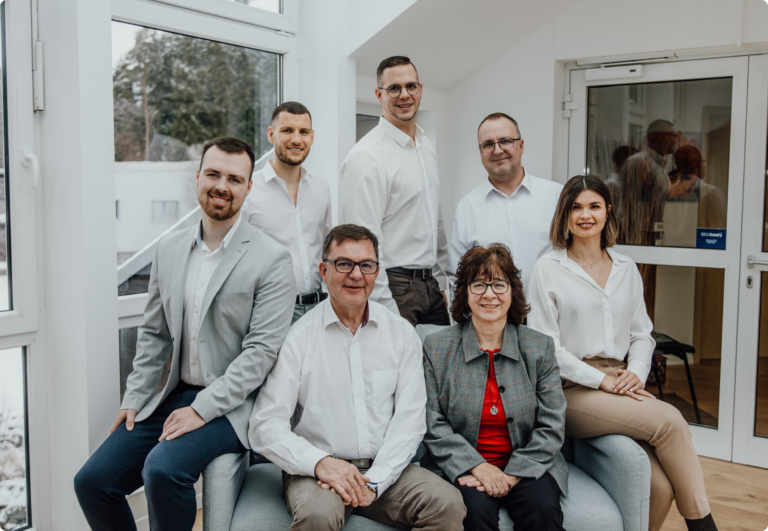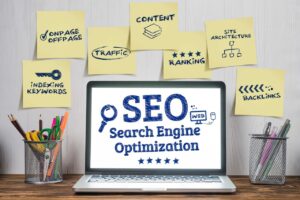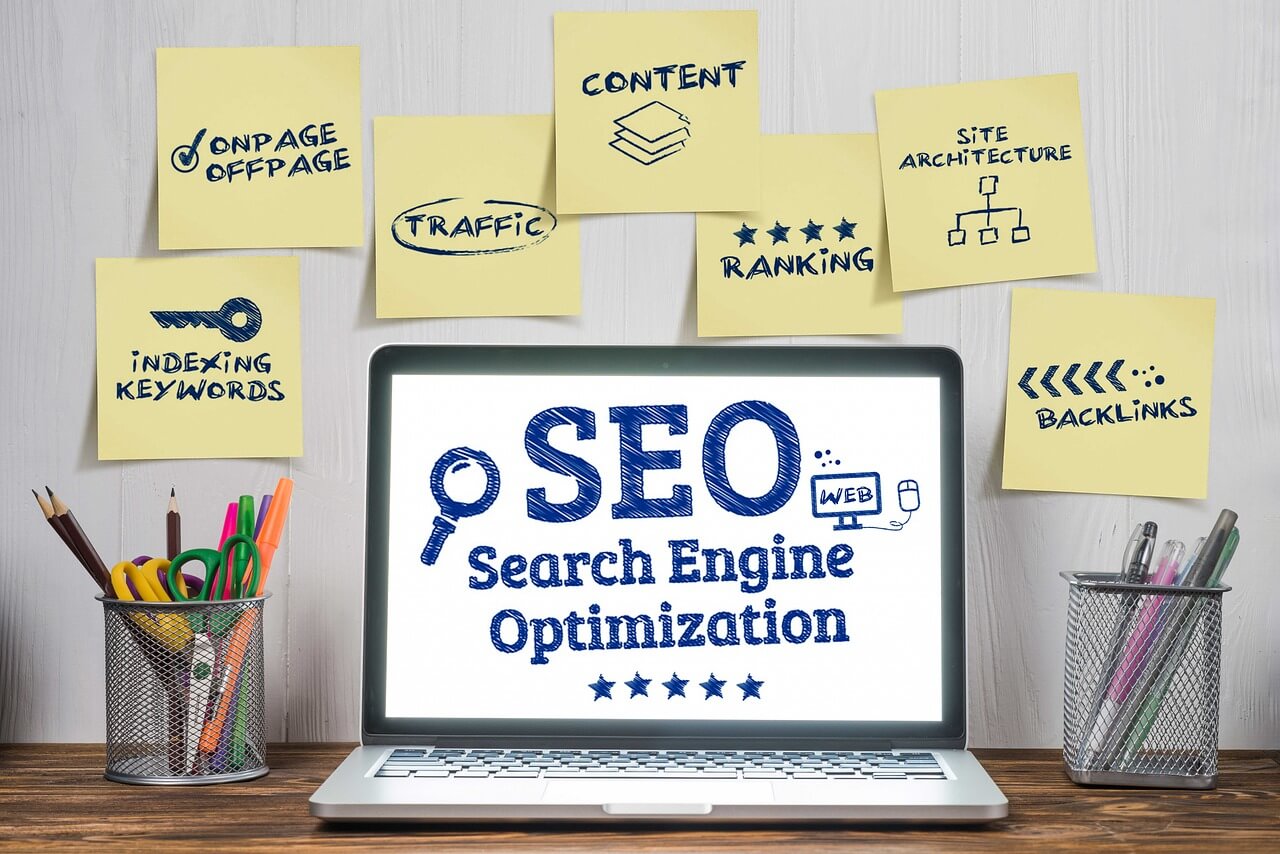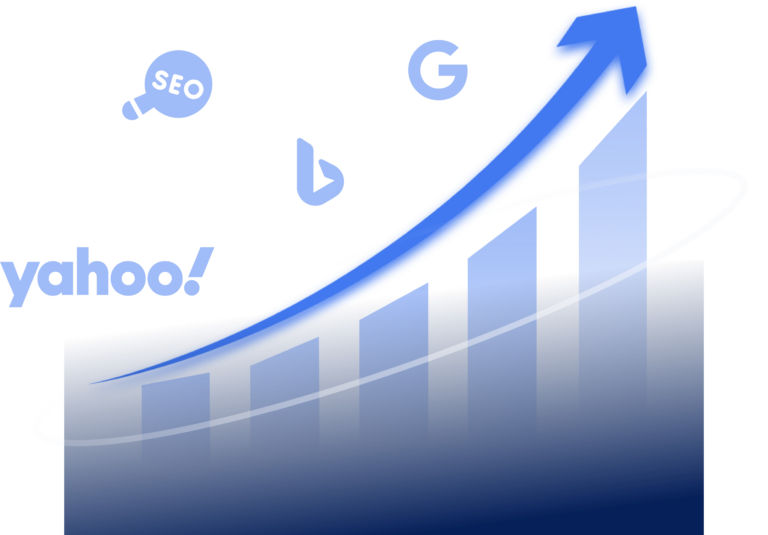The most important facts in brief:
- Over 60% of website traffic is generated via Google on average
- SEO requires patience and strategy, but pays off in the long term
- A professional SEO check uncovers optimization potential
- Keyword research, on-page and off-page optimization are central components
- High-quality, user-centered content is the key to success
In the digital world, SEO is the be-all and end-all of being visible online. On average, over 60% of website traffic is generated via Google – and the trend is rising! You know it yourself – before making a purchase or enquiring about a service, you first look for information online. As a company, you cannot afford to do without SEO optimization. But what does professional search engine optimization look like? 🤔
Website optimization is not a sprint, but a marathon. It takes patience, strategy and know-how to be at the top of the search results in the long term. It’s not just about individual SEO measures, but about a holistic concept. From keyword research to technical aspects and high-quality content – every aspect has to be right.
One thing is clear: without SEO, you lose valuable opportunities to be found by potential customers. But where to start? An SEO check by a professional can show you where your website stands and which adjustments you need to make. This will save you valuable time and resources and help you reach your goal faster. 🎯
In this article, you will learn how Search Engine Optimization works step by step and what really matters. We will show you the most important SEO measures that will improve your visibility on the web – be it via the Google Search Console or other tools.
Introduction to SEO for websites
SEO, the abbreviation for search engine optimization, is an important part of online marketing. It encompasses all measures aimed at improving the positioning of a website in the organic search results of search engines such as Google. By improving visibility, companies can reach more potential customers and increase their market share.
What is SEO?
SEO focuses on optimizing a website for search engines and users alike. This includes factors such as high-quality content, loading speed, website architecture, relevant keywords and backlinks. The main goal is to appear in the top positions of organic search results and thereby attract more visitors to the website.
The importance of SEO for companies
80-90% of online sessions begin with a search query on Google, making SEO essential for businesses. Websites on the first search results page have the best chance of attracting visitors and thus influencing business success. Especially for small and medium-sized companies in competitive markets, SEO can be a game changer. The goal should not just be to be in the top 10, but rather to be in the top three positions (top 3 position).
Advantages of SEO | Explanation |
|---|---|
More organic traffic | Better positioned websites attract more visitors |
Cost-effective in the long term | Once established, rankings continuously bring traffic from visitors who are interested in buying. |
Higher conversion rates | Organic visitors often show strong interest in offers – because they have googled for a solution to their problem |
Strengthening the brand | Top rankings increase visibility and trustworthiness |
In summary, SEO forms the basis for a successful online presence. If you recognize the importance of search engine optimization and implement it consistently, you will create a permanent source of free leads for your company.
The basics of search engine optimization
Search engine optimization (SEO) is a complex field with over 200 ranking factors that influence the visibility of your website in search results. SEO can be divided into three main areas: On-page optimization, off-page optimization and technical optimization. Each of these areas plays a crucial role in a successful ranking.
On-page optimization
OnPage SEO is concerned with improving content, page structure and technical aspects directly on your company’s website. It involves incorporating relevant keywords in titles, headings, texts and meta descriptions. In addition, a clear navigation should be designed and the loading speed optimized. The aim is to offer added value to users and search engines alike. In addition to these topics, a user-friendly and conversion-oriented website design is also important.
Off-page optimization
Off-page SEO includes all measures outside of your own website, in particular the creation of high-quality backlinks. Google evaluates factors such as industry proximity, link popularity and trust. The more high-quality websites link to your site, the better for your ranking. There are several strategies for getting free backlinks – but in highly competitive niches, you cannot avoid buying backlinks.
Technical optimization
Technical SEO ensures that your website functions without errors and can be optimally recorded by search engines. This includes aspects such as a correct page structure (URL structure), valid HTML code, an XML sitemap and an optimized robots.txt file. Loading speed and mobile-friendliness also play an important role, as Google takes these factors into account in its evaluation. Regularly check the technical optimization of your site with SEO tools: You should regularly carry out site audits that detect 404 errors, dead links or redirect chains, for example. If you correct these errors, your website is technically well set up.
Range | Examples of optimization measures |
|---|---|
On-Page | Keywords, titles, headings, texts, meta descriptions, navigation, internal linking |
Off-Page | Link building, industry proximity, link popularity, trust |
Technical | Page structure, HTML code, XML sitemap, robots.txt, loading speed, mobile-friendliness. Check with regular site audits from SEO tools. |
A holistic SEO strategy combines all three areas in order to sustainably improve visibility in search results and generate more organic traffic. It is important to always keep the user in mind and not just optimize for search engines.
Keyword research: The first step towards optimization
The basis of every successful SEO strategy is careful keyword research. Only if you know which search terms your target group uses to search for your offers can you optimize your website in a targeted manner. A thorough analysis helps you to understand the search habits of your potential customers and identify the right keywords.
Tools for keyword research
There are many helpful SEO tools that can help you with keyword research. One of the best known is the Google Keyword Planner, which is often used by advertisers to see estimated search volumes for specific keywords. SISTRIX and Ubersuggest are also popular options for finding relevant search terms and estimating their potential. Pay particular attention to your customer’s customer journey and put yourself in their shoes as best you can.
Tool | Advantages | Disadvantages |
|---|---|---|
Google Keyword Planner | Search volume forecasts, list import | Estimated data only |
Ubersuggest | Free of charge, exact search volumes | No list import |
SISTRIX | Comprehensive data, competitive analysis | Chargeable |
Discover long-tail keywords
Long-tail keywords – i.e. specific search queries consisting of several words – are particularly promising for your SEO. Although these have a lower search volume than general, short keywords, they also have less competition. As with short-tail keywords, you can also use long-tail keywords to target users who already have a clear intention to buy. A balanced mix of popular search terms and specific long-tail keywords is the key to success.
Short-tail keywords: 1-2 words, high search volume, high purchase intent, difficult to rank e.g. (“buy men’s shoes”)
Medium-tail keywords: 2-3 words, moderate search volume, somewhat easier to rank (“men’s shoes for winter”)
Long-tail keywords: 4+ words, low search volume, good ranking opportunities (“What are the best men’s shoes for winter”).


On-page optimization in detail
On-page optimization is a central component of search engine optimization. It includes technical, structural and content-related adjustments to a website in order to improve its ranking in search results. The most important elements of on-page optimization include title tags, meta descriptions, content quality, information structure, internal links and performance.
Title tags and meta descriptions
Title tags and meta descriptions (meta data) are essential for on-page optimization. The title tag is the most important ranking factor and should contain the main keyword. Meta descriptions influence the click-through rate and should be meaningful, contain the main keyword and be between 140 and 155 characters long.
Element | Recommendation | Example |
|---|---|---|
Title tag | Main keyword included, max. 60 characters | <title>SEO Agency Munich | Professional Search Engine Optimization</title> |
Meta description | Meaningful, main keyword included, 140-155 characters | <meta name=”description” content=”Increase your search engine ranking with our SEO agency in Munich. Benefit from our expertise in search engine optimization.” > |
Optimize heading structure
A well-structured headline hierarchy helps search engines to better understand the content of a page. The main heading (H1) should reflect the main topic of the page and contain the focus keyword. Sub-headings (H2-H6) serve to further subdivide the content and incorporate important keywords.
Image optimization
Images can also be optimized for search engines. Relevant file names and meaningful alt texts help crawlers to understand the image content. Compressed images also improve the loading speed of the page, which has a positive effect on the ranking.
Well thought-out on-page optimization makes content easier for search engines to understand and improves the ranking in search results. The visibility of a website can be significantly increased through the strategic use of keywords, a clear page structure and optimized media.
Off-page optimization: links and reputation
Off-page optimization includes all SEO measures that take place outside of your own website. The main objective is to increase the findability and authority of the website by building high-quality backlinks. This is not just about the pure number of links, but above all about their quality and thematic relevance.
The importance of backlinks
Backlinks are a central component of off-page SEO. They serve as recommendations and trust signals for search engines. Google’s PageRank algorithm is based on the analysis of links between websites. Not only the number, but also the quality and relevance of the backlinks are taken into account.
Off-page optimization | Goals |
|---|---|
Backlink building | Increase in domain popularity and ranking |
Reputation management | Improving perception and confidence |
Content marketing | Increase visibility and links through high-quality content |
Strategies for link building
There are various ways to build high-quality backlinks. These include, among others:
Guest articles on relevant blogs and websites
Press relations and mentions in online media
Creation of unique and useful content that people like to link to
Roundup link building through suggestions of your own blog posts
Analysis and replication of the competition’s link profile
It is always important to generate backlinks in a natural and organic way. Artificial or manipulative methods can be identified by Google as link spam and lead to penalties. Instead, the focus should be on creating high-quality content and building relationships with other websites.
Technical SEO: Improving website performance
Technical SEO is a decisive factor for the success of your website. Targeted optimizations in the background not only improve the user experience, but also boost your search engine ranking. Here you can see what technical SEO is all about and how you can get your website up to scratch! 🚀
Optimize loading speed
Activating HTTPS is a must for a good loading time and a better ranking. Google has been considering SSL encryption as a ranking factor since 2014. Fortunately, switching to HTTPS is no longer a major effort these days – many hosting providers offer SSL certificates as part of their packages. 🔒
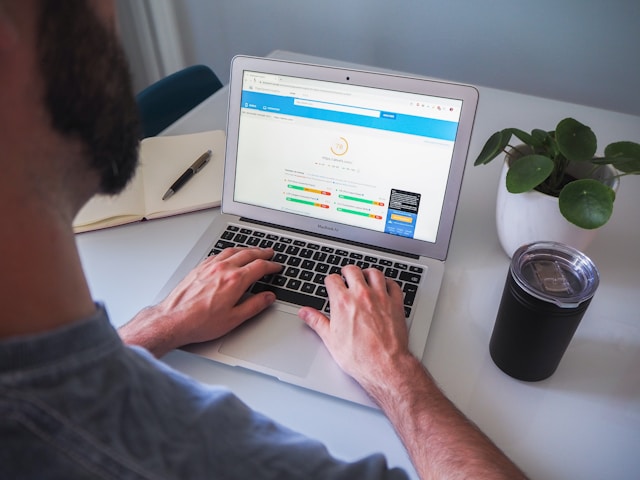

Ensure mobile-friendliness
In times of the mobile-first index, a mobile-friendly website is essential. Responsive design ensures that your website adapts to different screen sizes and also looks good on smartphones and tablets. A clear page structure and meaningful URLs not only make it easier for users to navigate and use, but also for search engine bots to work.
In addition to mobile user-friendliness, loading speed on mobile devices also plays a major role. With AMP (Accelerated Mobile Pages), super-fast loading times can be achieved – a real plus in view of the increasing mobile traffic. You should also keep an eye on the Core Web Vitals, which Google will take into account as ranking factors from 2021.


Overall, the user experience plays a major role. The longer someone stays on your website, the better signals it sends to Google. For the UX, it is important that your website is well structured and that everything is easy to access. As a rule of thumb, users should be able to reach everything from the homepage in three to a maximum of four clicks.
Content marketing and its role in SEO
Content marketing is a crucial component of a successful SEO strategy. Creating high-quality and relevant content with real added value for the target group is an important online marketing discipline. This not only improves search rankings in search results, but also builds a loyal readership.
High-quality content
At the heart of content marketing is first-class content that informs, entertains or inspires. This can be blog articles, videos, guides, infographics or interactive elements. It is crucial that the content addresses the needs and interests of the target group and provides added value.
The following aspects characterize high-quality content:
Relevance for the target group
Uniqueness and unique selling point
In-depth information and expertise
Attractive preparation and structure
Use of keywords for search engine optimization
Content distribution and promotion
First-class content alone is not enough – it must also be found and consumed. Targeted distribution and promotion of content is therefore essential. This is where different channels and tactics come into play:
Channel | Tactics | Goal |
|---|---|---|
Social media | Sharing links, interaction with followers | Increase reach and engagement |
E-mail marketing | Newsletter with valuable content | Guide readers to website |
Guest contributions | High-quality articles on other blogs | Generate backlinks and referral traffic |
Influencer cooperations | Collaboration with opinion leaders | Tapping into new target groups |
Clever content distribution ensures more visibility, traffic and ultimately a better search engine ranking. Because the more users consume and share the content, the more positively Google & Co. will rate it.


Local SEO for local businesses
For companies that mainly target local customers, optimization for local searches is essential. Through targeted measures in the area of local SEO, you can significantly increase your visibility for search queries with a regional reference and reach more people (and therefore potential customers) in your area.
Using Google My Business effectively
A key element of local search engine optimization is a fully completed and optimized Google My Business profile. Make sure that all important information such as address, opening hours, contact details and industry category are entered correctly. Add appealing photos to your profile and encourage satisfied customers to leave reviews. These measures signal to Google the relevance of your business for local search queries.
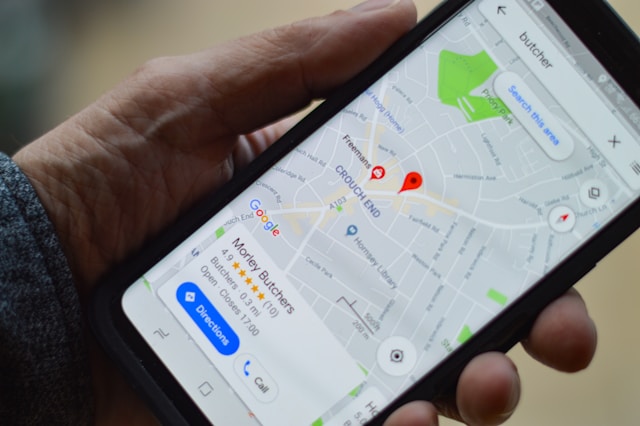

Targeted use of local keywords
In order to optimize your website for local searches, the use of local keywords is crucial. Naturally integrate relevant terms such as city or region names into your content, meta descriptions and alt tags. This will increase the likelihood of your company being found for local search queries. Always pay attention to user-friendliness and avoid excessive keyword stuffing.
Local SEO measure | Meaning |
|---|---|
Optimize Google My Business | Increases visibility for local search queries |
Use local keywords | Improves the ranking for regional search terms |
Reviews and links on local directories | Strengthens local online presence and authority |
By consistently implementing these local SEO strategies, you can optimally position your company for regional search results. Use the potential of local search to attract more customers and sustainably increase your success.
SEO analysis and monitoring
Regular monitoring is essential to measure and continuously improve the success of your SEO efforts. By monitoring key performance indicators, you can identify problems at an early stage and make targeted adjustments. 🔍📈
The most important SEO key figures at a glance
Focus on these key metrics to track the progress of your SEO strategy:
Organic traffic: How many visitors land on your website via organic search?
Rankings: In which positions does your website appear for relevant keywords?
Click-through rates(CTR): How often do users click on your search results?
Conversion rates: How many visitors perform desired actions, such as purchases or registrations?
Engagement metrics: Dwell time, bounce rate and page views per visit provide information about the quality of your content.
Powerful tools for SEO analysis
With the right SEO tools, you always have an overview of your SEO performance. Here are some of the best helpers:
Tool | Functions |
|---|---|
Google Analytics | Comprehensive website statistics, target group analysis, conversion tracking |
Google Search Console | Monitoring of rankings, clicks, impressions and crawling errors |
Ahrefs | Backlink analysis, keyword research, competitor monitoring |
SEMrush | Keyword research, ranking monitoring, site audit, backlink analysis |
Through the targeted use of these SEO tools and the regular analysis of relevant key figures, you can maintain an overview and continuously optimize your SEO strategy. This will help you achieve top rankings and more traffic for your website in the long term! Then nothing stands in the way of your SEO success! 🚀
Avoid the most common SEO mistakes
SEO can be a real challenge, but with the right knowledge and strategy, you can increase the success of your website. Let’s take a look together at the most common SEO mistakes and find out how you can avoid them.
1. missing or insufficient internal linking
Mistake: Poor internal linking prevents search engines from efficiently crawling and indexing all important pages on your website.
Solution: Use internal linking sensibly to improve the structure of your website and facilitate the crawling process. Link regularly to important pages within the content.
2. incorrect URL structure
Mistake: URLs that are long, complicated or overloaded with unnecessary parameters can confuse both users and search engines.
Solution: Ensure a clear and user-friendly URL structure that contains relevant keywords and is easy to read (e.g. www.deineseite.de/seo-fehler-vermeiden).
3. non-optimized images
Error: Images without alt tags or in a file size that is too large can negatively affect the loading speed and are not optimized for search engines.
Solution: Make sure that all images on your website have alt tags with relevant descriptions and compress the image files to improve the loading speed.
4. missing or inaccurate schema markup data (structured data)
Mistake: Without schema markup (structured data), your website lacks the ability to make its content more understandable to search engines, which reduces the chance of rich snippets.
Solution: Implement schema markup to help Google and other search engines better understand the content and enable rich snippets (e.g. reviews, events, recipes).
5. insufficient content quality
Mistake: A common mistake is to simply try to produce content in large quantities without paying attention to quality. This can lead to your website not performing well in the SERPs.
Solution: Focus on high-quality, relevant content that offers real added value for the target group and relies on expertise and authority.
Conclusion on professional SEO optimization
Professional SEO optimization is crucial for your long-term online success. With continuous adjustments, you can achieve higher rankings, more visibility and win customers. As 75% of searchers only look at the first page of Google searches, a well-founded keyword analysis and targeted use in headlines and content is essential. Off-page measures such as link building also increase your visibility.
SEO requires patience, but the long-term success and lower costs compared to search engine advertising make it worthwhile. Optimized content also creates valuable backlinks that further strengthen your ranking.
FAQ
What is the difference between SEO and paid advertising?
SEO aims to achieve better organic rankings in the search results and thus generate permanent free traffic. With paid ads such as GoogleAds, you can buy these rankings – but this requires a certain advertising budget. SEO is therefore a long-term process that generates sustainable traffic, whereas paid advertising only brings visitors as long as you pay for it.
How long does it take for SEO to deliver results?
This depends on many factors such as the competitive situation, the quality of the optimization and the initial position of the website. It usually takes several months before significant improvements in rankings and traffic become visible. SEO is a long-term strategy that brings continuous improvements.
Can small companies also benefit from SEO?
Absolutely! Especially for small and local companies, SEO can be very valuable in reaching potential customers nearby. With a clever local SEO strategy and good content, SMEs can also become more visible and attract more customers.
How much does professional search engine optimization cost?
You can implement simple measures yourself with a little training, but for a comprehensive strategy it often makes sense to work with us as SEO experts. We will be happy to help you with your project.
Which factors influence the Google ranking the most?
Google uses over 200 ranking factors. The relevance and quality of content are among the most important. High-quality, unique content and a good user experience (UX) are real ranking boosters. But meta data also plays a role.
How often should I update my website for a good SEO result?
Regular updates with fresh, relevant content signal to Google that a website is being maintained and provides useful information for users. The ideal frequency depends on the industry and resources and must be considered individually.
As a beginner, do I need a professional SEO expert?
It all depends on your own goals, previous knowledge and resources. As a motivated beginner, you may be able to tackle the basics such as keyword research, structured content and an optimized Google My Business entry yourself. For a holistic strategy and more complex technical, analytical and strategic aspects, it makes sense to work with us as an SEO agency.

